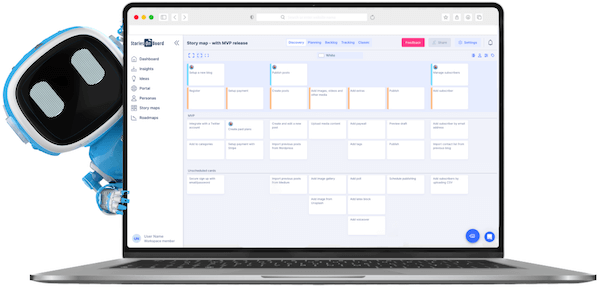Backlog refinement is a crucial step in agile project management, where teams prioritize and update their list of tasks, ensuring that the backlog is well-defined and reflects the current project needs. This process traditionally involves personal and team effort, extensive collaboration, and time-consuming meetings. However, the rise of AI and automation may transform this approach.
Contents
What is backlog refinement?
The backlog is a key element of the agile methodology, which serves as a dynamic, continuously updated, organized to-do list of work items that are prioritized according to their importance in providing value to the end user.
An effective product backlog is also a communication tool between the Product Owner or the Product Manager, the development team, and the stakeholders, providing a clear understanding of what work needs to be done, why, and in what order.
Refining the backlog, also known as backlog grooming is a regular process of reviewing the product backlog by the Product Owner (or Product Manager) and the Agile team.
This should be done to ensure that the development items on the backlog are still relevant and add value to the project or client as development progresses and despite possible changes to customer requirements.
The purpose of the backlog refinement meeting is to
- Eliminate backlog items (usually: user stories) that are no longer relevant
- If necessary, develop new user stories and add them to the backlog
- Re-prioritise items for the next sprint
- Review and re-estimate user stories based on new or updated information, rewrite acceptance criteria if needed
- Estimation of new user stories, and adding acceptance criteria
By taking the time to identify the priority tasks for the next sprint, the team can start planning the next sprint in time, and in a clear, transparent way, so that they can continue working without delay and with the user and customer goals in mind.
Benefits of backlog refinement
Backlog refinement offers numerous benefits to the team and the product. The process helps teams to stay up-to-date with customer needs and expectations, and efficiently execute projects.
In details:
- Discover dependencies and prevent roadblocks
- The discussions about the backlog and the project goals improve collaboration and alignment
- More accurate sprint planning
- More efficient prioritization
- Reduced time wasted on reworking and discussing misunderstandings
- Better products that users love
Who should attend a backlog refinement meeting?
It is not necessary for the entire cross-functional team and all stakeholders to be present at the backlog refinement meeting, but the agile team should be present and participate in the meeting.
The Product Owner (or the Product Manager) should call and facilitate the product backlog refinement meeting and it is useful if representatives of the QA team, the Project Manager, and the Scrum Master are involved.
Backlog refinement with AI
Artificial intelligence (AI) can be a huge help in refining the backlog. AI-powered solutions can streamline the process, making it more accurate and efficient. As a result, teams can save time and improve their confidence while also producing better products that users love.
AI-enabled solutions for backlog refinement leverage analytics, predictive modeling, and natural language processing technologies to automate user story writing, analyze the product backlog highlight shortcomings, and present new perspectives.
Continuous Discovery: Signal-Driven Backlog Refinement
Refinement doesn’t have to wait for a meeting. The shift is toward continuous discovery: a signal-driven flow where live customer feedback, product analytics, support chats, and market intel feed your backlog all week. AI turns the noise into structured opportunities, linking evidence to the user journey so you refine based on what users actually do and say.
In practice, continuous discovery pairs AI clustering and summarization with outcome-based prioritization. Signals are grouped by themes and Jobs-to-Be-Done, enriched with sentiment and impact, mapped to story cards, and scored against OKRs, so priorities auto-refresh before planning. That keeps the backlog current, cuts bias, and surfaces high-leverage ideas early.
- Connect the key signal sources: analytics events, NPS/CSAT, support tickets, reviews, sales notes, and research clips.
- Auto-triage with AI: de-duplicate, tag themes and personas, extract JTBD, and summarize the evidence.
- Attach signals to story-map cards to show opportunity size, confidence, and recent trend movement.
- Prioritize by outcomes (e.g., OKRs) using dynamic RICE/ICE scores that update as new data lands.
- Run lightweight experiments (feature flags, A/B tests) and loop the results straight back into the backlog.
- Keep a human-in-the-loop review and decision log to ensure transparency and sound product judgment.
With built-in feedback management and AI assistance, platforms like StoriesOnBoard make continuous discovery practical—turning your story map into a living, evidence-backed backlog that’s always ready for the next sprint.
Expand your knowledge, follow us for more!
How to do backlog refinement with StoriesOnBoard’s AI features?
StoriesOnBoard is a product management platform built around story mapping. Story maps are visual backlogs of user stories, which display user steps and goals in a user journey. The greatest strength of historical maps is that they are easy for everyone to understand and use, making it easier to hold multi-participant discussions about necessary changes to the backlog.

StoriesOnBoard’s AI-powered solution enables agile teams to streamline and partly automate the backlog refinement process. The platform’s AI features provide tools for user story and acceptance criteria generation, and automated release summary and release announcement writing. The tool also offers various prioritization frameworks, data-driven insights, automated feedback collection and management, and streamlined collaboration.
By leveraging StoriesOnBoard’s AI capabilities, teams can quickly find gaps and new ideas, visualize their backlogs as story maps, and plan their sprints with confidence. The platform also integrates seamlessly with existing project management software like Jira, Azure DevOps, and Trello, allowing teams to easily sync their projects with their issue trackers.
With StoriesOnBoard’s AI-powered features, teams are able to quickly uncover potential roadblocks before they become an issue. This allows teams to be more efficient because they can plan the sprints and ultimately the product more accurately.
Summary
Backlog refinement can be a series of cumbersome, doubtful, and time-consuming meetings, but it shouldn’t be. A lot can depend on the expertise and experience of the Product Owner or the Product Manager who held those meetings, but there is help to make it easier for them.
Tools – like StoriesOnBoard – with visual backlogs and AI features can surely make it easier to facilitate discussions about the backlog and refine the user stories according to the changes of the user or client requirements.
AI helps automate and speed up content writing tasks so that nothing important is overlooked and no important step is missed. Your task is simply to gather the team around the story map and discuss the proposed changes and new items.
FAQ: AI and the Future of Backlog Refinement
How does AI cut time spent on backlog refinement?
It drafts user stories and acceptance criteria, proposes priorities, and generates release summaries. You spend less time writing and more time deciding, so refinement runs shorter and stays focused.
Will AI replace the Product Owner or Product Manager?
No. It speeds up content creation and surfaces insights, but prioritization and trade-offs are still human calls. AI amplifies your judgment; it doesn’t replace it.
What inputs does the AI need to generate useful user stories?
Share product goals, personas, and high-level journeys or epics. The AI drafts stories and acceptance criteria; you and the team refine them together on the story map.
How does story mapping work with AI in StoriesOnBoard?
Story maps show user steps and goals, turning your backlog into a shared view. AI helps seed and enrich the map, so gaps and opportunities stand out.
Can AI help identify dependencies and potential roadblocks?
Yes. It scans backlog items and context to flag missing details, risks, and dependencies early, so you can sequence work and avoid blockers.
What prioritization support is available?
StoriesOnBoard includes several prioritization frameworks plus data-driven signals. Re-rank items for upcoming sprints and share the why with stakeholders.
How does it integrate with Jira, Azure DevOps, or Trello?
Sync story maps and backlog items with Jira, Azure DevOps, or Trello. Updates flow both ways, keeping planning and execution in sync.
How should we run refinement ceremonies with AI involved?
Run shorter, more frequent sessions and use AI drafts as the starting point. Spend time validating value, tightening acceptance criteria, confirming estimates, and clearing dependencies.
What outcomes can teams expect?
Quicker refinement cycles, clearer priorities, and fewer misalignments. Teams plan sprints with confidence and ship work users actually value.
Can AI write release summaries and announcements?
Yes. StoriesOnBoard’s AI drafts release summaries and announcements you can tailor for stakeholders and customers.
